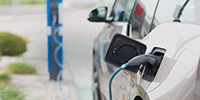There are different types of lawnmower how should I replace it?
|
Several years after purchasing a lawnmower, the battery needs replacing, just like a car battery. Lawnmower batteries serve the same function as a car battery to start and operate the engine as well as other electrical functions, such as headlights in a riding mower. Changing the battery in all styles of lawnmowers, whether they are push or riding mowers, follows the same process as changing a car battery. Parka riding lawnmower or move a push lawnmower onto a flat surface. Turn the engine off and allow the blades and all moving parts to stop. Let the lawnmower cool for a few minutes. Locate the battery in your lawnmower. Riding mowers battery placement is under either the seat or the hood. Push mower batteries are generally on the deck near the handle in a black box. Tell the Size of a Lawnmower BatteryThe last thing you want on mowing day is a battery that won't start your riding mower. Fortunately, finding a suitable replacement for a dead battery is not difficult since most riding mowers will accept batteries of a standard size and voltage. Variations in battery construction, though, can make some batteries a better choice than others, and some replacement batteries might not work in your mower at all Voltage The voltage rating of a battery is a measure of how much current can flow through it at a given time. Nearly all riding lawn mower batteries are 12-volt batteries, as are most automotive and other vehicle batteries. Some batteries labelled as mower batteries are higher voltage -- as much as 36 or 40 volts -- but these are usually specialized batteries made to power electric walk-behind mowers and shouldn't be confused with riding mower batteries. Size and Terminal Position Batteries are classified by their physical size, and individual size categories are given a "group number" by the Battery Council International. Most riding lawn mower batteries are group U1 batteries; they are about 8.3 inches long, 5.1 inches wide and 7.25 inches high. There are two types of these batteries, differentiated by the position of their positive terminals. U1 batteries have their positive terminals on the left, and U1R batteries have their positive terminals on the right. The difference is significant because the length of a mower's battery cables can prevent a battery with the incorrect terminal position from fitting. Always check the terminal position of your old battery before you buy a replacement. Cold Cranking Amps Batteries are rated in regard to the "cold-cranking amps" they can produce. The CCA rating measures how much current the battery can deliver in 30 seconds at zero degrees Fahrenheit; the higher the number, the more power the battery can put out in a quick burst at low temperatures. Although you're unlikely to be using your riding mower when the temperature is below zero, the CCA rating can give you an idea of how robust the battery will be on chilly days. Put on safety glasses and gloves to protect you from battery acid. Pour 1 cup of water and 1 teaspoon of household baking soda into a disposable cup. Mix the contents thoroughly with a spoon to dissolve the baking soda. Pour the baking soda mixture on the battery terminals to dissolve any corrosion that binds the battery cables to the terminals. Insert a flat-head screwdriver into the battery-stabilizing bracket, if your model of lawnmower has one. Turn the screw counterclockwise to loosen the screw and push the bracket to one side. Place an adjustable wrench on the negative terminal and turn it counterclockwise to loosen it. The negative terminal has a "-" sign on it and the black battery cable is connected to it. Loosen the positive, red battery cable in the same manner. Pull each battery cable up and off the old battery. Remove the battery from the battery box by the center handle and set it aside. Insert the pointed end of a battery terminal cleaner into each battery cable. Turn the cleaner in a circle to remove any rust or corrosion that inhibits the battery from working properly. Clean each cable until the inside of the circles is shiny. Wipe any excess metal shavings out with a shop towel. Place the new lawnmower battery in the box. Dip a forefinger into petroleum jelly and apply a thick coating to the new battery terminals. This will keep the new battery from developing corrosion. Place the red, positive battery cable on the positive terminal and tighten it with an adjustable wrench. Replace the black negative terminal in the same manner. Replace the battery bracket and tighten the screws clockwise to hold it in place. Take your old battery to a recycling center, car service station or auto parts store. Batteries are toxic and must be properly disposed of. |














